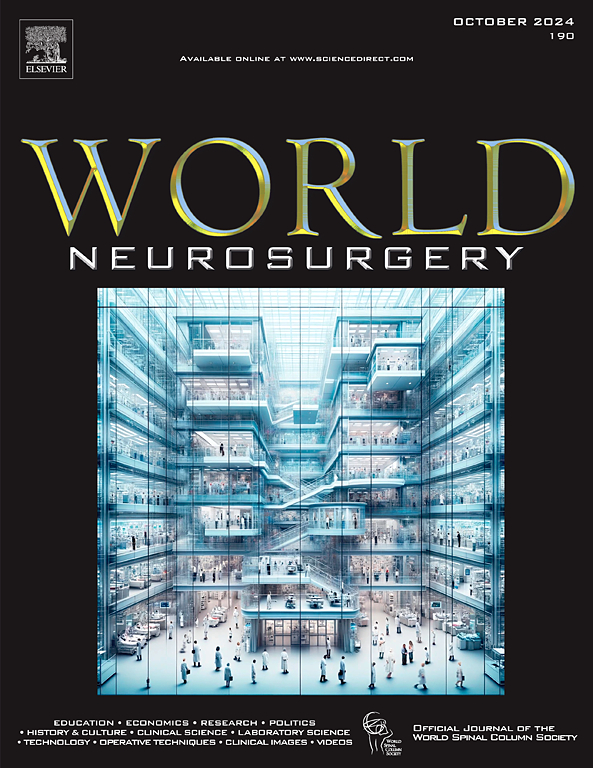一种新的用于增强计算机断层扫描灌注容量评估的自动化软件。
IF 1.9
4区 医学
Q3 CLINICAL NEUROLOGY
引用次数: 0
摘要
目的:评估UKIT(一种新型的自动计算机断层扫描灌注(CTP)软件)对急性缺血性脑卒中(AIS)梗死结局的预测价值,并将其灌注容量评估与MIStar进行比较。材料和方法:收集中国一家医院AIS患者的数据,所有参与者在再灌注治疗前接受CTP治疗。使用Spearman等级相关、Bland-Altman图和kappa检验来评估两个软件之间CTP测量的一致性。对于接受血管内治疗(EVT)并实现完全再通的AIS患者,使用Spearman秩相关评估CTP测定的缺血核心体积(ICV)与基础真实值之间的一致性。结果:在纳入的278例患者中,UKIT测量的缺血核心和低灌注体积与MIStar测量结果具有很强的相关性(缺血核心:r = 0.982, ICC = 0.902, P < 0.001;灌注不足:r = 0.979, ICC = 0.956, P < 0.001)。结论:自动化CTP软件UKIT可靠地评估缺血核心和低灌注容量,有助于临床选择AIS患者进行再灌注治疗。本文章由计算机程序翻译,如有差异,请以英文原文为准。
A New Automated Software for Enhanced Computed Tomography Perfusion Volume Assessment
Objective
To evaluate the predictive value of UKIT, a novel automated computed tomography perfusion (CTP) software, for infarct outcomes in acute ischemic stroke (AIS) and compare its perfusion volume assessments with those of MIStar.
Methods
Data from AIS patients were collected across 1 Chinese hospital, with all participants undergoing CTP prior to reperfusion therapy. The concordance of CTP measures between the two softwares was assessed using Spearman rank correlation, Bland-Altman plots, and kappa tests. For AIS patients who received endovascular treatment (EVT) and achieved complete recanalization, consistency between the ischemic core volume as determined by CTP and the ground truth was assessed using Spearman rank correlation.
Results
In the included 278 patients, the ischemic core and hypoperfusion volumes measured by UKIT correlated strongly with MIStar's measurements (ischemic core: r = 0.982, intraclass correlation coefficient = 0.902, P < 0.001; hypoperfusion: r = 0.979, intraclass correlation coefficient = 0.956, P < 0.001). Excellent agreement was observed between the two softwares according to imaging criteria in EXTEND (kappa = 0.73, P < 0.001) and DEFFUSE 3 (kappa =0.73, P < 0.001). Among the 103 patients who underwent EVT and achieved full recanalization, 86 (83.5%) underwent diffusion-weighted imaging within 24 hours post-EVT. Ischemic core volume assessed by both UKIT and MIStar was found to be in close agreement with the ground truth (UKIT: r = 0.695, P < 0.001; MIStar: r = 0.721, P < 0.001).
Conclusions
The automated CTP software UKIT reliably assesses ischemic core and hypoperfusion volumes, aiding in the clinical selection of AIS patients for reperfusion therapy.
求助全文
通过发布文献求助,成功后即可免费获取论文全文。
去求助
来源期刊

World neurosurgery
CLINICAL NEUROLOGY-SURGERY
CiteScore
3.90
自引率
15.00%
发文量
1765
审稿时长
47 days
期刊介绍:
World Neurosurgery has an open access mirror journal World Neurosurgery: X, sharing the same aims and scope, editorial team, submission system and rigorous peer review.
The journal''s mission is to:
-To provide a first-class international forum and a 2-way conduit for dialogue that is relevant to neurosurgeons and providers who care for neurosurgery patients. The categories of the exchanged information include clinical and basic science, as well as global information that provide social, political, educational, economic, cultural or societal insights and knowledge that are of significance and relevance to worldwide neurosurgery patient care.
-To act as a primary intellectual catalyst for the stimulation of creativity, the creation of new knowledge, and the enhancement of quality neurosurgical care worldwide.
-To provide a forum for communication that enriches the lives of all neurosurgeons and their colleagues; and, in so doing, enriches the lives of their patients.
Topics to be addressed in World Neurosurgery include: EDUCATION, ECONOMICS, RESEARCH, POLITICS, HISTORY, CULTURE, CLINICAL SCIENCE, LABORATORY SCIENCE, TECHNOLOGY, OPERATIVE TECHNIQUES, CLINICAL IMAGES, VIDEOS
 求助内容:
求助内容: 应助结果提醒方式:
应助结果提醒方式:


